Is Mold Good for Compost
Yes, mold is beneficial and necessary for your compost pile's decomposition process. You'll notice different types of mold, each playing a specific role: white and brown molds indicate healthy decomposition, while green/blue Penicillium offers natural antibiotic benefits. These fungi break down organic matter, improve soil structure, and enhance moisture retention. To maintain healthy mold growth, keep your pile as moist as a wrung-out sponge and monitor its temperature between 120°F and 160°F. While black mold suggests poor conditions and should be addressed, most molds are working hard to transform your kitchen scraps and yard waste into nutrient-rich soil. Understanding the different types of mold can help you create superior compost.
This post may contain affiliate links. If you make a purchase through these links, I may earn a commission at no additional cost to you. Additionally, portions of this post may be generated using artificial intelligence (AI) technology. While we strive for accuracy, please be aware that AI-generated content may not always be perfect and should be fact-checked when necessary.
The Spatula Scoops
- Most molds in compost are beneficial, particularly white and brown varieties that actively break down organic matter into nutrient-rich soil.
- Mold presence typically indicates healthy decomposition and creates better conditions for beneficial organisms like earthworms and helpful bacteria.
- Different colored molds serve various purposes, with white mold accelerating decomposition and brown mold enriching soil structure.
- Mold helps improve soil moisture retention, enhances plant disease resistance, and contributes to creating a balanced composting ecosystem.
- While most molds are good, black mold should be monitored as it may indicate poor conditions or potential harmful elements.
Understanding Mold in Composting
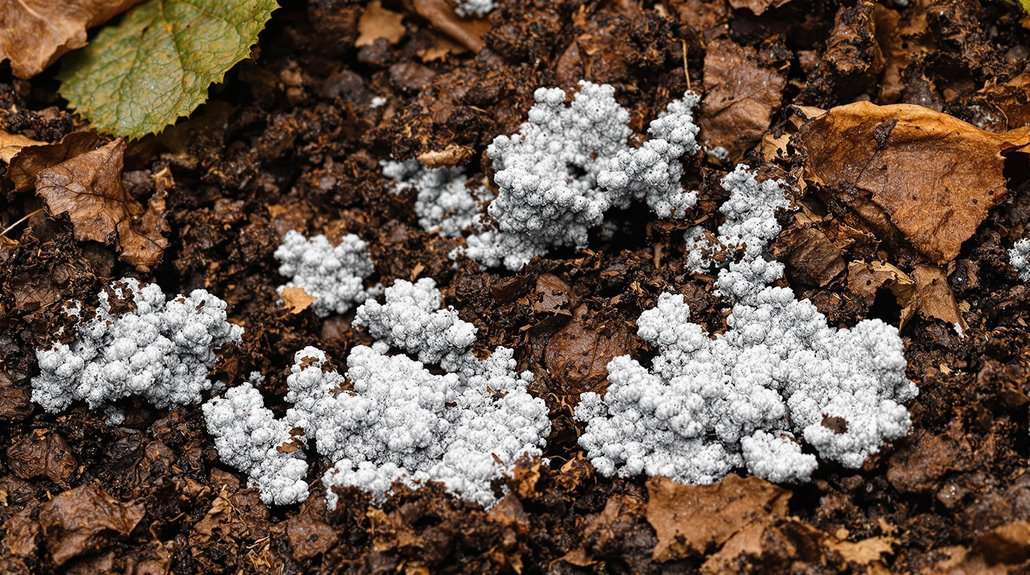
When you spot mold growing in your compost pile, it's actually a good sign. Mold, particularly in the form of leaf mold, plays a vital role in breaking down organic matter through fungal decomposition, transforming your yard waste into valuable soil amendments.
You'll find that leaf mold offers numerous benefits for your garden's ecosystem. It's particularly effective at improving soil structure, enhancing moisture retention, and creating an environment where beneficial organisms like earthworms can thrive. Research shows that leaf mold compost can provide higher disease resistance in garden plants. If you're looking to create leaf mold, you'll need to collect deciduous leaves and pile them in a shady area, allowing them to decompose over one to two years.
When you're working with leaf mold, it's important to be selective about your materials. You'll want to avoid leaves that may have been exposed to pesticides or chemical fertilizers. For best results, you can speed up the decomposition process by shredding the leaves before piling them and maintaining proper moisture levels. Remember to keep your pile damp but not waterlogged, and consider turning it occasionally to promote even breakdown throughout the material.
Types of Beneficial Mold
When you're checking your compost pile, you'll likely notice different colored molds, including white, blue, green, and brown varieties, which are all beneficial signs of healthy decomposition. These naturally occurring molds play essential roles in breaking down organic materials, with each color indicating different stages and conditions within your composting process. You can feel confident that these common mold colors are working to transform your kitchen scraps and yard waste into nutrient-rich compost, though you'll want to use basic safety precautions like wearing gloves and avoiding direct contact with the spores. White mold species are particularly beneficial since they help accelerate the breakdown of organic matter in your pile.
Common Mold Colors
During the composting process, you'll likely encounter various types of mold that play essential roles in breaking down organic matter. The most common colors you'll see are white, brown, green/blue, and black, each indicating different conditions in your compost pile.
White and brown molds are highly beneficial for your compost. You'll find that white mold is a positive sign, indicating active decomposition and nutrient enrichment. When you spot brown mold, you can rest assured it's helping break down organic materials effectively while contributing to soil enrichment. Simple leaf piles work best for encouraging beneficial mold growth.
Green or blue mold, typically Penicillium, offers antibiotic benefits to your pile, though you'll want to wear protective gear when handling it as it can trigger allergic reactions. It's also worth noting that its presence might signal excess moisture in your compost.
If you notice black mold in your pile, you'll need to take action. It's a warning sign of poor composting conditions and can produce harmful mycotoxins. When black mold appears, you shouldn't use the compost, and you'll need to adjust your pile's conditions to restore proper balance.
Safe Decomposition Signs
Identifying safe decomposition signs in your compost pile starts with recognizing beneficial mold types. You'll want to look for white and brown molds, which are your allies in breaking down organic materials efficiently. White mold specializes in decomposing tough materials, while brown mold works steadily to release nutrients into your compost.
You'll know your decomposition process is healthy when you spot actinomycetes, which look like gray spider webs stretching through your pile. These filamentous bacteria typically appear near the end of composting and are excellent at breaking down complex materials like cellulose, lignin, and proteins. These specialized organisms contribute to the earthy soil smell that indicates a thriving compost ecosystem. You might also notice beneficial organisms like Fuligo septica or Bird's Nest Fungus, which target woody materials specifically.
If you're seeing Penicillium molds, particularly those with a bluish tint, don't worry – they're harmless and actually speed up your composting process. Remember that fungi play a vital role by breaking down materials that bacteria can't handle effectively, especially when conditions are too dry, acidic, or low in nitrogen. They're fundamentally preparing the way for bacterial decomposition to continue the process.
The Science Behind Decomposition
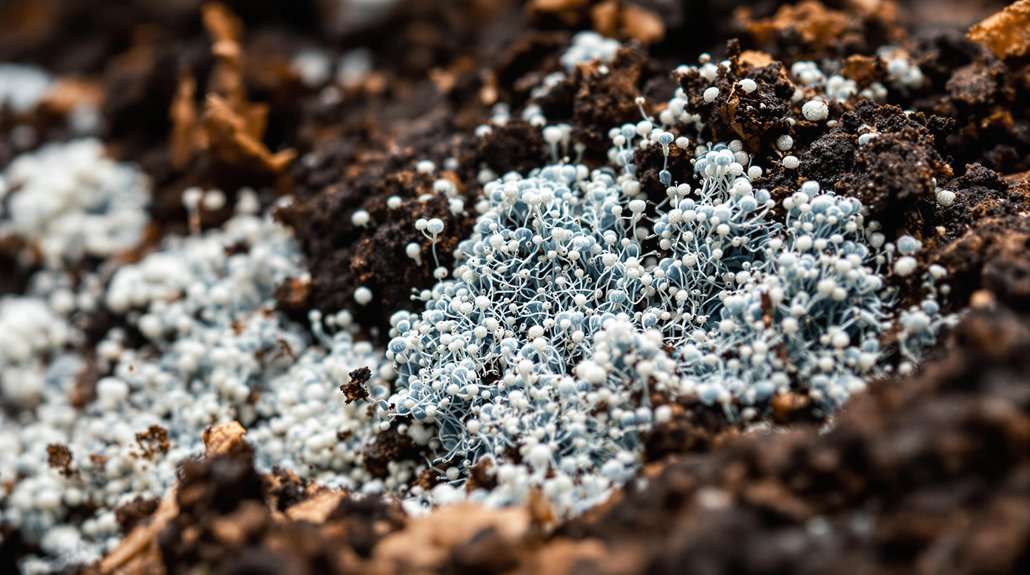
When you're learning about compost decomposition, it's important to understand the distinct roles of fungi and bacteria, as fungi break down tough organic materials like leaves and wood while bacteria primarily process softer, nitrogen-rich materials. Throughout the decay process, complex chemical changes occur as enzymes break down cellulose, lignin, and other organic compounds into simpler forms that plants can use. You'll find that temperature plays a vital role in this process, with fungal decomposition typically occurring at lower temperatures (50-80°F) compared to bacterial breakdown, which requires higher temperatures (130-150°F) for ideal activity. Leaf mold decomposition occurs more slowly than traditional composting since it relies primarily on fungal activity.
Fungal Vs Bacterial Breakdown
Understanding the difference between fungal and bacterial breakdown in composting helps you create better compost for your garden. You'll notice that fungal breakdown, which occurs primarily in leaf mold, is a slower process that can take years but creates superior soil enrichment. In contrast, bacterial breakdown works much faster, often completing within months while generating significant heat. Maintaining proper moisture levels during decomposition is essential for both fungal and bacterial processes to work effectively.
| Characteristic | Fungal Breakdown | Bacterial Breakdown |
|---|---|---|
| Speed | Slow (years) | Fast (months) |
| Temperature | Cool process | Hot process |
| Visual Signs | White mycelium | Steam, heat |
| Best Materials | Leaves, woody matter | Kitchen scraps, grass |
| Ideal Conditions | Shady, moist | Warm, well-mixed |
When you're managing your compost pile, you'll want to evaluate which method suits your needs. If you're looking for quick results, bacterial breakdown through hot composting is your best choice. However, if you're aiming for premium soil amendment and don't mind waiting, fungal breakdown will give you richer, more beneficial results. The white mold you'll see in your compost pile is actually beneficial mycelium, indicating healthy fungal decomposition at work.
Chemical Changes During Decay
The science behind decomposition in your compost pile comes down to complex chemical reactions breaking larger molecules into simpler compounds. When organic matter decomposes, chemical bonds are broken through a process that requires energy, often in the form of heat generated by microbial activity. You'll find that this process follows the basic decomposition formula: AB → A + B, where complex materials break down into simpler substances.
Just like catalysts can speed up reactions, certain microorganisms in your compost accelerate the decomposition process naturally. As your compost materials decompose, they undergo true chemical changes, not just physical alterations. Unlike physical changes such as water evaporating from your pile, these chemical transformations permanently alter the molecular structure of the materials. You'll notice these changes as your kitchen scraps and yard waste break down into humus. The process is similar to how carbonic acid decomposes in carbonated drinks, though much more complex. Environmental factors in your pile, including temperature, moisture, and acidity levels, directly influence the rate of these chemical reactions. When the decomposition process is complete, you'll have stable compounds that won't break down further under normal composting conditions.
Signs of Healthy Compost
Many gardeners can identify healthy compost by several key characteristics. When you're examining your compost pile, you'll want to look for specific physical, biological, and chemical indicators that show it's ready to use. Well-matured compost should have a rich, dark brown to black color and feel crumbly when you handle it, similar to the soil you'd find in a forest. Unlike traditional compost, fungal decomposition is the primary method that creates leaf mold in garden beds.
- Your compost should have an earthy, pleasant smell without any strong or offensive odors
- You'll notice beneficial insects and earthworms moving throughout the pile
- The texture should be uniformly broken down with very few recognizable scraps
- White, thread-like fungal growth (mycelium) indicates healthy decomposition
- The material should feel light and fluffy, not wet or compacted
When you're checking your compost's readiness, you'll find that properly finished material has a neutral to slightly alkaline pH and contains balanced nutrient levels. A healthy pile supports robust microbial activity and contains high levels of humus, which you can identify by its dark color and soil-like consistency. These characteristics guarantee your compost will effectively improve soil structure and provide essential nutrients to your plants.
Managing Moisture and Temperature
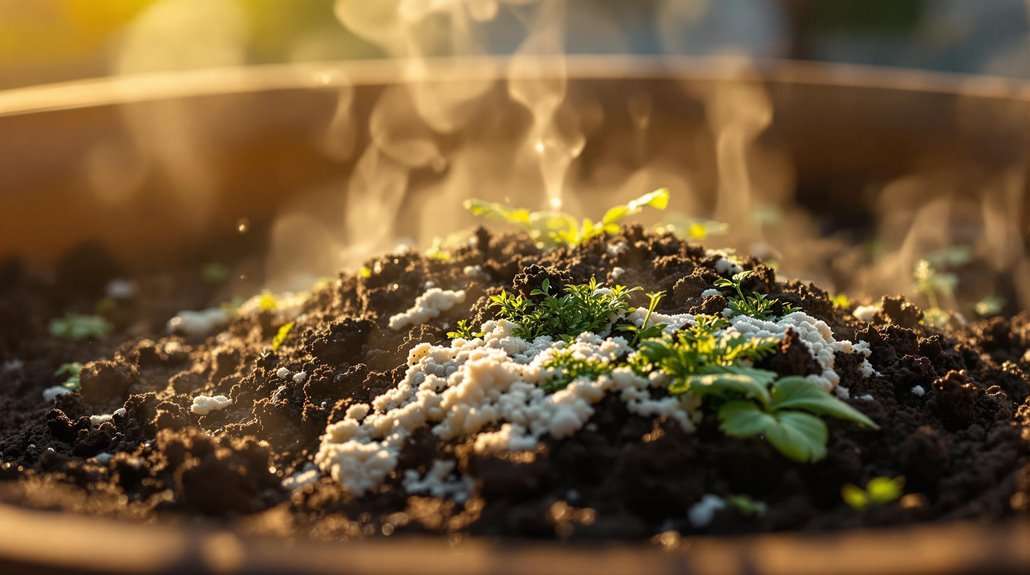
Ideal Moisture Conditions
- Cover your leaf pile with a tarp or plastic sheet to retain vital moisture
- Shred leaves before adding them to increase surface area for better moisture distribution
- Mix in materials like shredded paper or straw to help regulate moisture levels
- Turn your pile regularly to guarantee even moisture throughout
- Add diverse leaf types to maintain ideal moisture balance
You can improve your compost's moisture retention by incorporating different organic materials like coffee grounds, which not only help with moisture control but also speed up decomposition. Remember that while consistent moisture is essential, you don't want your pile to become waterlogged. Proper moisture levels will support earthworm activity and maintain the fungal networks vital for breaking down organic matter efficiently.
Temperature Control Methods
Temperature control in leaf mold composting requires a delicate balance between moisture management and proper aeration. You'll find that leaf mold piles operate at cooler temperatures than traditional compost heaps, primarily due to the fungal decomposition process. To maintain ideal conditions, you'll need to keep your pile moist, similar to a damp sponge, while ensuring adequate airflow through occasional turning.
When managing your leaf mold pile's temperature, it's important to avoid overheating, which can kill beneficial microbes. You can regulate temperature by turning the pile every few weeks, though you shouldn't turn it too frequently as this might disrupt fungal growth. If you notice the pile becoming too dry, add water during turning to maintain proper moisture levels. Conversely, if it's too wet, spread the materials out to improve air circulation.
For best results, consider covering your pile with a tarp during mid-summer to help retain moisture and accelerate decomposition. You'll know you're maintaining the right conditions when the pile feels consistently damp but not waterlogged, and the leaves gradually break down into a dark, crumbly material.
Common Composting Mistakes
Despite its seeming simplicity, composting can go wrong in several common ways that backyard gardeners often encounter. You'll want to avoid these mistakes to guarantee your compost pile functions effectively and produces high-quality material for your garden. The key is understanding what materials to use and how to maintain proper conditions for decomposition.
- Don't add evergreen leaves, diseased plant materials, or pesticide-treated vegetation to your pile
- Maintain proper moisture levels – your pile should feel like a wrung-out sponge
- Turn your pile regularly to guarantee adequate aeration and prevent anaerobic conditions
- Shred leaves before adding them to speed up decomposition
- Test your soil before applying compost to prevent nutrient imbalances
When you're managing your compost pile, you'll need to pay attention to the carbon-to-nitrogen ratio and encourage beneficial organisms like earthworms and mycelium. It's also essential to recognize that leaf mold and traditional compost are different products with distinct uses. While leaf mold excels as a moisture-retaining mulch, compost serves as a soil amendment. You shouldn't rely solely on compost as a fertilizer, as this can lead to incomplete plant nutrition.
Accelerating the Composting Process
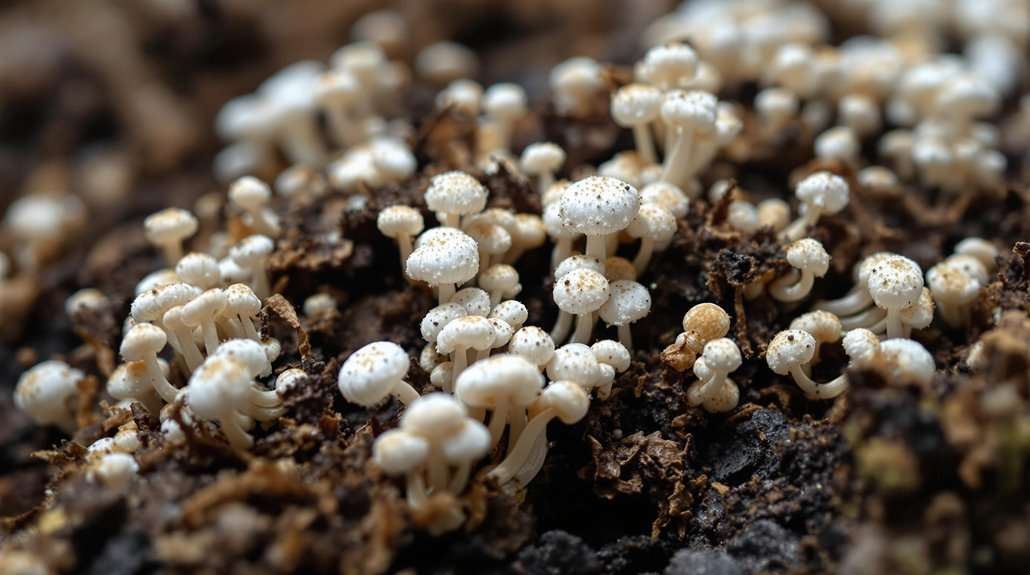
Once you've mastered the basics of composting, you can speed up the process by implementing several proven techniques. The key is to optimize conditions for microorganisms that break down organic matter, particularly fungi, which play an essential role in leaf decomposition.
You'll want to start by shredding your leaves, as smaller pieces create more surface area for microbes to work on. Using a lawnmower or dedicated leaf shredder is an effective way to accomplish this. Next, maintain proper moisture levels by regularly checking and adjusting the pile's water content – it should feel like a wrung-out sponge. Wire mesh bins provide excellent containment while allowing proper airflow.
To further accelerate decomposition, you'll need to guarantee proper aeration by turning your pile periodically and avoiding over-compaction. Adding nitrogen-rich materials can help balance the carbon-to-nitrogen ratio, while placing a tarp over the pile during summer months builds beneficial heat. You'll also want to position your compost in a shaded area to maintain consistent moisture and encourage fungal growth.
Monitor your pile regularly for signs of proper decomposition, including an earthy smell and dark coloring. Remember to avoid including diseased plant materials, which can contaminate your entire batch.
Garden Benefits of Moldy Compost
Beneficial molds in your compost pile do more than just break down organic matter – they're essential allies in creating nutrient-rich soil for your garden. When you incorporate moldy compost into your soil, you'll notice improved structure, enhanced water retention, and better overall plant health. These microscopic decomposers work tirelessly to transform organic materials into a dark, crumbly substance that's ideal for your plants. While decomposition may take one full year, the resulting leaf mold creates exceptional growing conditions.
- White and brown molds help break down tough plant fibers, making nutrients more accessible
- Penicillium species (blue-green molds) provide natural antibiotic benefits to your soil
- Leaf mold improves soil structure and creates ideal growing conditions
- Beneficial fungi suppress plant diseases and promote stronger root systems
- Various mold types attract earthworms and beneficial bacteria to your garden
You can use your moldy compost in multiple ways to maximize its benefits. Apply it as a mulch to control weeds and retain moisture, mix it into your potting soil for better drainage, or use it as a nutrient-rich starter mix for seedlings. Just remember to let your compost fully decompose before application, and always wear protective gear when handling moldy materials.
Best Materials for Composting
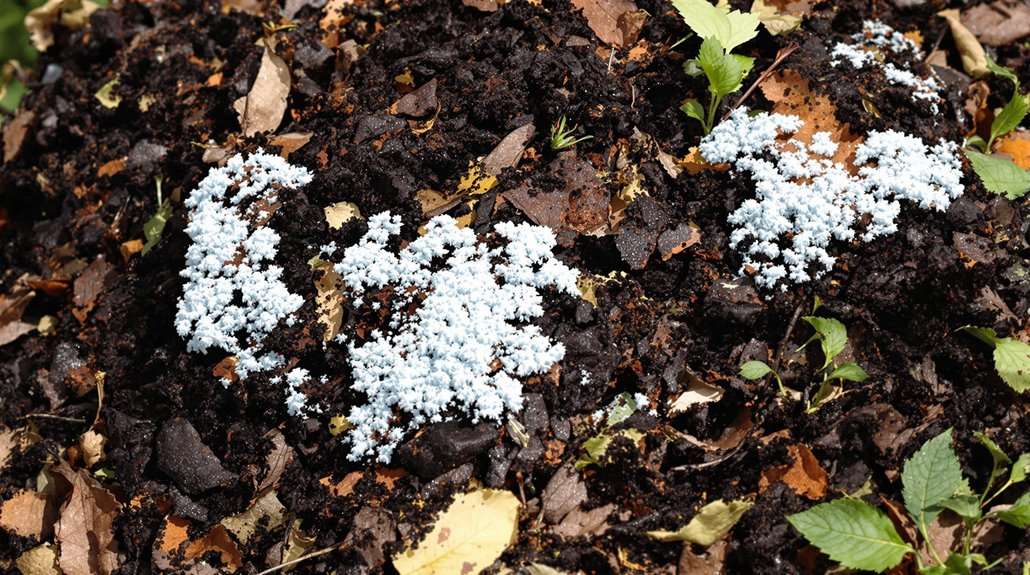
Creating successful compost starts with choosing the right mix of materials. You'll want to focus on balancing your carbon-rich "browns" with nitrogen-rich "greens" in a ratio of about 2:1 or 3:1. For your browns, dry leaves, straw, and shredded newspaper work exceptionally well, as they provide structure and help maintain proper air circulation throughout your pile.
When it comes to greens, you can't go wrong with fruit and vegetable scraps, grass clippings, and coffee grounds. These nitrogen-rich materials help speed up decomposition and maintain essential moisture levels. You'll also find that herbivorous animal manure serves as an excellent natural activator for your compost. Maintaining temperatures between 120°F and 160°F will enhance the speed of decomposition. Proper storage of organic materials, such as apple juice, at refrigerator temperatures can help prevent spoilage and maintain their nutritional value.
There are some materials you'll need to avoid completely. Don't add meat, bones, or fatty foods, as they'll attract unwanted pests and create unpleasant odors. Steer clear of pet waste from non-herbivorous animals, diseased plants, and weedy materials with seeds. Start your pile with a base layer of twigs or mulch for drainage, then alternate your layers of greens and browns while maintaining moisture similar to a wrung-out sponge.
Creating Rich Soil Amendments
With your composting materials properly selected, you can turn your attention to developing rich soil amendments. Leaf mold compost stands out as an exceptional choice for enriching your garden's soil structure and promoting healthy plant growth. You'll find that creating this valuable amendment requires patience, but the results are worth the wait when you're working to improve your soil's quality.
To create effective soil amendments using leaf mold, you'll need to follow these essential steps:
- Collect and shred fallen deciduous leaves to speed up the decomposition process
- Maintain proper moisture levels by watering your leaf pile regularly
- Turn the pile occasionally to guarantee proper aeration and faster breakdown
- Monitor the decomposition progress over 1-2 years
- Test your soil before applying to determine ideal application rates
You can incorporate your finished leaf mold into various gardening applications, from potting mixes to garden beds. The amendment works particularly well when mixed with traditional compost, creating a balanced growing medium that retains moisture while improving drainage. By using leaf mold as a soil amendment, you're adding valuable organic matter that supports beneficial microorganisms and enhances overall soil health.
Frequently Asked Questions
Can Moldy Kitchen Scraps Make My Pets Sick if They Dig in Compost?
Yes, moldy kitchen scraps in your compost can seriously harm your pets if they dig in and consume them. Decomposing organic matter often contains harmful pathogens like E. coli and Salmonella, which can cause severe gastrointestinal problems. You'll need to keep your compost bin securely closed with pet-proof latches, and if your pet shows symptoms like vomiting or diarrhea after exposure, seek immediate veterinary care.
Does Adding Moldy Bread Speed up the Composting Process Significantly?
"One person's trash is another's treasure," but when it comes to moldy bread in compost, you won't find a significant speedup. While mold indicates active decomposition, adding moldy bread doesn't substantially accelerate the overall composting process. You're better off focusing on maintaining proper carbon-to-nitrogen ratios, adequate moisture, and regular turning of your pile for ideal decomposition rates.
Should I Wear a Mask When Turning Compost With Visible Mold?
Yes, you should definitely wear a mask when turning compost with visible mold. While small amounts of mold aren't usually dangerous, disturbing moldy compost releases spores into the air that can cause respiratory issues and allergic reactions. For complete protection, you'll want to wear an N95 mask, gloves, and eye protection. If you're particularly sensitive to mold, it's best to have someone else handle the turning process.
Can Compost Mold Damage Nearby Plants or Vegetables in My Garden?
Just as a healthy immune system protects your body, properly composted mold actually shields your garden. While active compost should be kept separate from growing areas, well-decomposed compost with mold won't harm your plants. You'll want to verify your compost is fully mature before applying it near vegetables. If you notice white, gray, or brown molds, they're typically beneficial and help break down organic matter, improving soil health.
How Long Can I Store Finished Compost Before Mold Becomes Problematic?
You can store finished compost for 3-6 months under ideal conditions before mold becomes a significant concern. To extend this timeframe, you'll need to maintain proper moisture levels (40-50%) and guarantee adequate aeration. Keep your stored compost covered but ventilated, and turn it periodically every 2-3 weeks. If you notice white or gray mold developing, immediately adjust moisture levels and increase aeration through turning.





